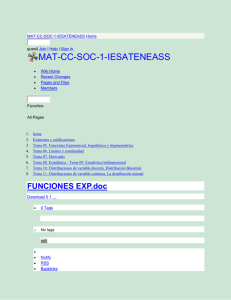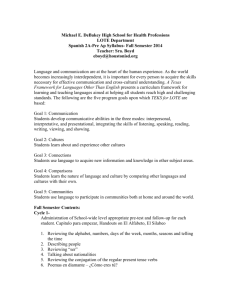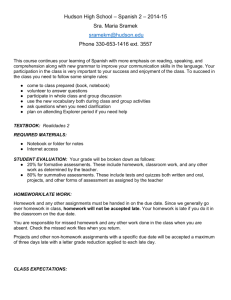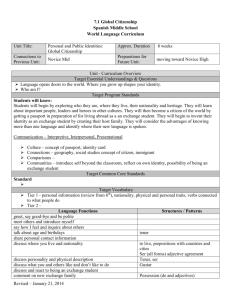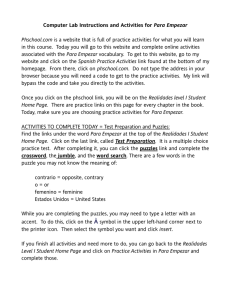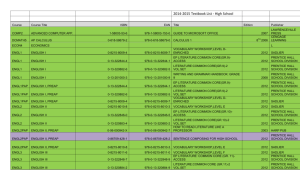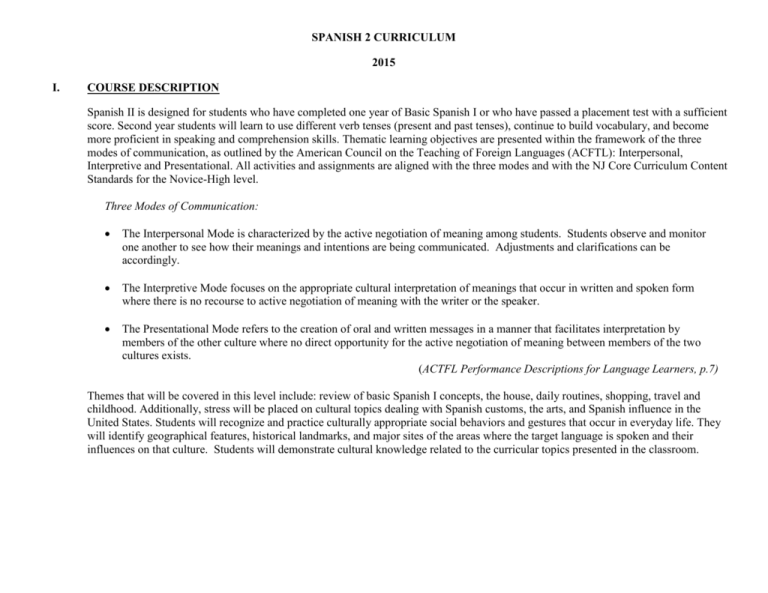
SPANISH 2 CURRICULUM
2015
I.
COURSE DESCRIPTION
Spanish II is designed for students who have completed one year of Basic Spanish I or who have passed a placement test with a sufficient
score. Second year students will learn to use different verb tenses (present and past tenses), continue to build vocabulary, and become
more proficient in speaking and comprehension skills. Thematic learning objectives are presented within the framework of the three
modes of communication, as outlined by the American Council on the Teaching of Foreign Languages (ACFTL): Interpersonal,
Interpretive and Presentational. All activities and assignments are aligned with the three modes and with the NJ Core Curriculum Content
Standards for the Novice-High level.
Three Modes of Communication:
The Interpersonal Mode is characterized by the active negotiation of meaning among students. Students observe and monitor
one another to see how their meanings and intentions are being communicated. Adjustments and clarifications can be
accordingly.
The Interpretive Mode focuses on the appropriate cultural interpretation of meanings that occur in written and spoken form
where there is no recourse to active negotiation of meaning with the writer or the speaker.
The Presentational Mode refers to the creation of oral and written messages in a manner that facilitates interpretation by
members of the other culture where no direct opportunity for the active negotiation of meaning between members of the two
cultures exists.
(ACTFL Performance Descriptions for Language Learners, p.7)
Themes that will be covered in this level include: review of basic Spanish I concepts, the house, daily routines, shopping, travel and
childhood. Additionally, stress will be placed on cultural topics dealing with Spanish customs, the arts, and Spanish influence in the
United States. Students will recognize and practice culturally appropriate social behaviors and gestures that occur in everyday life. They
will identify geographical features, historical landmarks, and major sites of the areas where the target language is spoken and their
influences on that culture. Students will demonstrate cultural knowledge related to the curricular topics presented in the classroom.
II.
COURSE OBJECTIVES/OUTLINE
PCTI SPANISH II Curriculum Unit 1 Planner
Content Area:
Unit Plan Title:
Spanish II
Grade(s)
9, 10, 11, 12
Para Empezar (Preliminary Unit)
CCS Standard(s) Addressed
7.1.NH.A.1- A.8
7.1.NH.B.1- B.5
7.1.NH.C.1- C.5
Essential Questions (3-5)
How would you describe yourself and others (personality, physical description) in English and Spanish?
Where are you and others from and how do you describe one’s nationality?
What activities do you and others do in your free time?
How often do you and others participate in certain activities?
Grammatical Concepts
Review of:
Classroom informal commands
The verb SER
Descriptive adjectives and a review of masculine/feminine/singular/plural rules
The construction SER + de + a place
The verbs SER vs. ESTAR
Regular AR, ER, & IR verb conjugations
Words of frequency
Interrogative words
Anchor Text
Realidades 2 (print and online interactive textbook) – Pearson Prentice Hall, 2014
Realidades 2 online practice workbook – Pearson Prentice Hall, 2014
Realidades 2 Writing, Audio and Visual workbook [WAV] (print and online interactive textbook) – Pearson Prentice Hall, 2014
Informational Texts (3-5)
“El primer día de clases”/ “The First Day of Classes” – p. 1
“Una población diversa”/A Diverse Population” – p. 6
“Enrique Iglesias” – p.11
Short Texts (1-3)
“¿Cómo eres?” / “What Are You Like?” – p. 2
“¿Qué haces?” / “What do you do?” – p. 8
“Proyecto Amanda – Mi descripción” / “Project Amanda – My description” (http://www.proyectoamanda.com/fanzine/midescripcion-3/)
Suggested Reading/Writing/Speaking/Listening Assessments (Formative & Summative)
Activities may include, but are not limited to:
Para Empezar Communicative Writing & Speaking Activity P-1- p. 9, Teacher Resource Book (Presentational & Interpersonal)
Para Empezar Audio Activities 1, 2 & 3 - pp.1-2, WAV book (Interpretive)
Para Empezar Writing Activities 4, 5 & 6 – pp.3-5, WAV book (Presentational)
The verb SER & adjetives quiz
Regular Verbs Quiz
Self-description project
End of unit summative assessment
Resources (websites, Blackboard, documents, etc.)
www.successnetplus.com
www.phschool.com
www.conjuguemos.com
www.quizlet.com
www.wordreference.com
Google Classroom
Presentational resources (such as, but not limited to Google Drive (Docs, Slides, Forms, Drawings), Prezi, Storyboard That,
Vocaroo)
Microsoft Office Programs (Documents, Power Points)
Blackboard
Youtube
Other websites, as needed, such as Spanish language online news and magazines
Realidades 2 Audio CDs, MP3 files
Realidades 2 video accompanyments (DVD set, video files)
Suggested Time Frame:
4 weeks
Content Area:
Unit Plan Title:
Spanish II
Grade(s)
9, 10, 11, 12
Tema 6A – En mi dormitorio (In My Bedroom)
CCS Standard(s) Addressed
7.1.NH.A.1- A.8
7.1.NH.B.1- B.5
7.1.NH.C.1- C.5
Essential Questions (3-5)
How would you describe your bedroom, home furnishings and their arrangement in Spanish?
What comparisons can be made between your bedroom and that of other teens?
How do your bedroom, its color(s) and your home entertainment choices reflect your personality?
What are some things you can and can’t do at home?
What are your sleeping habits and why are they important?
Grammatical Concepts
Bedroom & electronics vocabulary
Color words – masculine/feminine/singular/plural
Regular and irregular comparatives
Superlatives
Stem-changing verbs o-ue
Anchor Text
Realidades 1 (print and online interactive textbook) – Pearson Prentice Hall, 2014
Realidades 1 online practice workbook – Pearson Prentice Hall, 2014
Realidades 1 Writing, Audio and Visual workbook [WAV] (print and online interactive textbook) – Pearson Prentice Hall, 2014
Realidades 1 Teacher Resource Book, Temas 5-9 – Pearson Prentice Hall, 2014
Realidades 1 Guided Practice Workbook – Pearson Prentice Hall, 2014
Informational Texts (3-5)
“Making Comparisons” – p. 278
“The superlative” – p. 280
“¿Qué significan los colores?”/ “What do colors mean?” – p. 283
“Stem-changing verbs: poder and dormir” –p. 284
“¿Cuántas horas duermes?” / “How many hours do you sleep?” – p. 286
Short Texts (1-3)
“A primera vista” / “First Glance” – p. 272
“El cuarto de Ignacio” / “Ignacio’s Room” – pp. 274-75
“El desastre en mi dormitorio” / “The Mess in My Room” – pp. 288-89
Suggested Reading/Writing/Speaking/Listening Assessments (Formative & Summative)
Activities may include, but are not limited to:
Tema 6A Communicative Speaking Activities 1 & 2 –pp.68-71, Teacher Resource Book (Interpersonal)
Tema 6A Situation Cards Writing and Speaking Activities A & B –p. 72, Teacher Resource Book (Presentational/Interpersonal)
Tema 6A Audio Activities 5, 6, 7 & 9 –pp. 112-113,115, WAV book (Interpretive)
Tema 6A Writing Activities 10 & 11 –pp.116-117, WAV book (Presentational)
Tema 6A Videohistoria Listening and Writing Activity –pp.108-111, WAV book (Interpretive/Presentational)
Tema 6A Vocabulary Quiz
Tema 6A Comparisons Quiz
Tema 6A Stem-changing verbs quiz
Bedroom description project
End of unit summative assessment
Resources (websites, Blackboard, documents, etc.)
www.successnetplus.com
www.phschool.com
www.conjuguemos.com
www.quizlet.com
www.wordreference.com
Google Classroom
Presentational resources (such as, but not limited to Google Drive (Docs, Slides, Forms, Drawings), Prezi, Storyboard That,
Vocaroo)
Microsoft Office Programs (Documents, Power Points)
Blackboard
Youtube
Other websites, as needed, such as Spanish language online news and magazines
Realidades 1 Audio CDs, MP3 files
Realidades 1 video accompanyments (DVD set, video files)
5-6 weeks
Suggested Time Frame:
Content Area:
Unit Plan Title:
Spanish II
Grade(s)
9, 10, 11, 12
Tema 6B – ¿Cómo es tu casa? (What Is Your House Like?)
CCS Standard(s) Addressed
7.1.NH.A.1- A.8
7.1.NH.B.1- B.5
7.1.NH.C.1- C.5
Essential Questions (3-5)
What is your house like, what furniture is in each room and where are the rooms situated?
How is your house similar to or different from houses in Spanish speaking countries?
Which chores are you responsible for at home?
How would you give advice to someone?
How would you talk about what people are doing at the present moment?
Grammatical Concepts
House vocabulary
Affirmative tú commands
Present progressive tense
Anchor Text
Realidades 1 (print and online interactive textbook) – Pearson Prentice Hall, 2014
Realidades 1 online practice workbook – Pearson Prentice Hall, 2014
Realidades 1 Writing, Audio and Visual workbook (print and online interactive textbook) – Pearson Prentice Hall, 2014
Realidades 1 Teacher Resource Book, Temas 5-9 – Pearson Prentice Hall, 2014
Realidades 1 Guided Practice Workbook – Pearson Prentice Hall, 2014
Informational Texts (3-5)
“El patio”/”The patio” – p. 303
“Cómo son las casas en el mundo hispano?”/ “What are homes like in the Spanish speaking world?” – p.314
“Affirmative tú commands” – p. 305
“The present progressive tense” – p. 308
Short Texts (1-3)
“Los quehaceres de Elena” / “Elena’s Chores” – pp. 300-301
“¿Qué casa están buscando?” / “What house are they looking for?” – pp. 310-311
Suggested Reading/Writing/Speaking/Listening Assessments (Formative & Summative)
Activities may include, but are not limited to:
Tema 6B Communicative Speaking Activities 1 & 2 –pp.94-97, Teacher’s Resource Book (Interpersonal)
Tema 6B Situation Cards Writing and Speaking Activities A & B, p. 98, Teacher’s Resource Book (Presentational/Interpersonal)
Tema 6B Floor Plan Puzzle (Interpretive/Presentational)
Tema 6B House Ad Reading Activity: http://articulo.mercadolibre.com.pe/MPE-411737385-vendo-casa-de-finos-acabados-y-enbuen-estado-motivoviaje-_JM (Interpretive)
Tema 6B House Ad Writing Activity (Presentational)
Tema 6B Internet Activity (House Search) “Mi casa es tu casa” / “My house is your house”: www.lestartit.net
(Interpretive/Presentational)
Tema 6B Audio Activities 4 & 5-p. 302 (in TB) (Interpretive)
Tema 6B Audio Activities 5, 6, 7 & 8 –pp.123-124, WAV book (Interpretive)
Tema 6B Videohistoria Listening and Writing Activity –pp.120-122, WAV book (Interpretive/Presentational)
Tema 6B Vocabulary quiz
Tema 6B Affirmative Tú commands quiz
Tema 6B Present progressive quiz
My Dream House Project
Real Estate Agent/Buyer Interpersonal Assessment
End of unit summative assessment
Resources (websites, Blackboard, documents, etc.)
www.successnetplus.com
www.phschool.com
www.conjuguemos.com
www.quizlet.com
www.wordreference.com
Google Classroom
Presentational resources (such as, but not limited to Google Drive (Docs, Slides, Forms, Drawings), Prezi, Storyboard That,
Vocaroo)
Microsoft Office Programs (Documents, Power Points)
Blackboard
Youtube
Other websites, as needed, such as Spanish language online news and magazines
Realidades 1 Audio CDs, MP3 files
Realidades 1 video accompanyments (DVD set, video files)
5-6 weeks
Suggested Time Frame:
Content Area:
Unit Plan Title:
Spanish II
Grade(s)
9, 10, 11, 12
Tema 2A – ¿Cómo te preparas? (How Do You Get Ready?)
CCS Standard(s) Addressed
7.1.NH.A.1- A.8
7.1.NH.B.1- B.5
7.1.NH.C.1- C.5
Essential Questions (3-5)
How do you get ready for a special event?
What is your daily routine?
How do you express an action done to or for oneself?
Grammatical Concepts
Daily routine & special events vocabulary
Reflexive verbs
Anchor Text
Realidades 2 (print and online interactive textbook) – Pearson Prentice Hall, 2014
Realidades 2 online practice workbook – Pearson Prentice Hall, 2014
Realidades 2 Writing, Audio and Visual workbook [WAV] (print and online interactive textbook) – Pearson Prentice Hall, 2014
Realidades 2 Teacher Resource Book, Temas 1-4 – Pearson Prentice Hall, 2014
Realidades 2 Guided Practice Workbook – Pearson Prentice Hall, 2014
Informational Texts (3-5)
“La ropa de fiesta”/”Party Clothes” – p. 79
“Reflexive Verbs” – p. 80
“La familia y los eventos especiales” / “Family and Special Events” – p. 84
Short Texts (1-3)
“A primera vista”/”At First Glance” – pp. 74-75
“¿Más maquillaje?” / “More Makeup?” – pp. 76-77
“Y no hago más na’”/”And I Don’t Do Anything Else” (song lyrics by El Gran Combo de Puerto Rico)
Suggested Reading/Writing/Speaking/Listening Assessments (Formative & Summative)
Activities may include, but are not limited to:
Communicative Speaking Activity: ¿Qué usas para prepararte para la mañana? / What do you use to get ready in the morning?
(handout), (Interpersonal)
Tema 2A Situation Cards Writing and Speaking Activities A & B- p.88, Teacher’s Resource Book (Presentational/Interpersonal)
Reflexive Verbs Stations Activities (Interpretive/Interpersonal/Presentational)
Tema 2A Audio Activities 5 & 6 –p. 28, WAV book (Interpretive)
Tema 2A Writing Activity 11- p.32, WAV book (Interpretive)
Tema 2A Videohistoria Listening and Writing Activity –pp. 25-27, WAV book (Interpretive/Presentational)
Tema 2A Vocabulary quiz
My Daily Routine project
End of unit summative assessment
Resources (websites, Blackboard, documents, etc.)
www.successnetplus.com
www.phschool.com
www.conjuguemos.com
www.quizlet.com
www.wordreference.com
Google Classroom
Presentational resources (such as, but not limited to Google Drive (Docs, Slides, Forms, Drawings), Prezi, Storyboard That,
Vocaroo)
Microsoft Office Programs (Documents, Power Points)
Blackboard
Youtube
Other websites, as needed, such as Spanish language online news and magazines
Realidades 2 Audio CDs, MP3 files
Realidades 2 video accompanyments (DVD set, video files)
3-4 weeks
Suggested Time Frame:
Content Area:
Unit Plan Title:
Spanish II
Grade(s)
9, 10, 11, 12
Tema 7A – ¿Cuánto cuesta? (How Much Is It?)
CCS Standard(s) Addressed
7.1.NH.A.1- A.8
7.1.NH.B.1- B.5
7.1.NH.C.1- C.5
Essential Questions (3-5)
What are you wearing and what do you wear to a party, a game, to school, to a special event, to the beach?
What are some similarities/differences in the clothing styles and sizes of American teens vs. teens in Latin America?
How can you express your wants and preferences while shopping?
How can you point out specific items that you are referring to?
Grammatical Concepts
Clothing Vocabulary
Numbers 100-1,000,000
Stem-changing verbs e-ie
Demonstrative Adjectives
Anchor Text
Realidades 1 (print and online interactive textbook) – Pearson Prentice Hall, 2014
Realidades 1 online practice workbook – Pearson Prentice Hall, 2014
Realidades 1 Writing, Audio and Visual workbook [WAV] (print and online interactive textbook) – Pearson Prentice Hall, 2014
Realidades 1 Teacher Resource Book, Temas 5-9 – Pearson Prentice Hall, 2014
Realidades 1 Guided Practice Workbook – Pearson Prentice Hall, 2014
Informational Texts (3-5)
“The currencies of Bolivia, Peru and Costa Rica” – p. 328
“¡No sé qué talla uso!” /”I Don’t Know What Size I Am!” – p.109 (Realidades 2 textbook)
“Stem-changing verbs: pensar, querer, and preferir” – p.330
“Demonstrative Adjectives” – p. 332
Short Texts (1-3)
“A primera vista”/”At First Glance” – pp. 322-323
“Una noche especial”/”A Special Night” – pp. 324-325
“Tradiciones de la ropa panameña” / “Panamanian Clothing Traditions” –pp. 336-337
Suggested Reading/Writing/Speaking/Listening Assessments (Formative & Summative)
Activities may include, but are not limited to:
Tema 7A Communicative Speaking Activities 1 & 2 –pp. 124-127, Teacher’s Resource Book (Interpersonal)
¿Qué llevas hoy? / What are you wearing today? Paired communicative activity, handout, (Interpersonal)
Tema 7A Situation Cards Writing and Speaking Activities A & B –p.128, Teacher’s Resource Bk (Presentational/Interpersonal)
Tema 7A Internet Activity: El Corte Inglés – www.elcorteingles.es (Interpretive/Presentational)
Tema 7A Audio Activity 5 -p. 326 (in TB) (Interpretive)
Tema 7A Audio Activity 10 -p. 328 (in TB) (Interpretive)
Tema 7A Audio Activities 5, 6, & 7 –pp. 133-134, WAV book (Interpretive)
Tema 7A Writing Activity 10 –p. 136, WAV book (Presentational)
Tema 7A Writing Activity 9-p. 328 (in TB) (Presentational)
Tema 7A Videohistoria Listening and Writing Activity –pp. 120-122, WAV book (Interpretive/Presentational)
Tema 7A Vocabulary quiz
Tema 7A Numbers 100-1,000,000 quiz
Tema 7A Stem-changing verbs quiz
Tema 7A Demonstrative Adjectives Quiz
Store/Shopping Simulation Paired Practice & Assessment
Storyboard That store dialog project
End of unit summative assessment
Resources (websites, Blackboard, documents, etc.)
www.successnetplus.com
www.phschool.com
www.conjuguemos.com
www.quizlet.com
www.wordreference.com
Google Classroom
Presentational resources (such as, but not limited to Google Drive (Docs, Slides, Forms, Drawings), Prezi, Storyboard That,
Vocaroo)
Microsoft Office Programs (Documents, Power Points)
Blackboard
Youtube
Other websites, as needed, such as Spanish language online news and magazines
Realidades 1 Audio CDs, MP3 files
Realidades 1 video accompanyments (DVD set, video files)
5-6 weeks
Suggested Time Frame:
Content Area:
Unit Plan Title:
Spanish II
Grade(s)
9, 10, 11, 12
Tema 7B – ¡Qué regalo! (What A Gift!)
CCS Standard(s) Addressed
7.1.NH.A.1- A.8
7.1.NH.B.1- B.5
7.1.NH.C.1- C.5
Essential Questions (3-5)
Where do you typically go shopping and what are your shopping habits?
How are your shopping habits similar to or different from those of teens in Spain & Latin America?
How can you express activities that you and others did in the past?
Grammatical Concepts
Store Vocabulary
Nouns that end in -ería
The preterite of AR verbs
The preterite of CAR, GAR, & ZAR verbs
Direct Object Pronouns
Anchor Text
Realidades 1 (print and online interactive textbook) – Pearson Prentice Hall, 2014
Realidades 1 online practice workbook – Pearson Prentice Hall, 2014
Realidades 1 Writing, Audio and Visual workbook [WAV] (print and online interactive textbook) – Pearson Prentice Hall, 2014
Realidades 1 Teacher Resource Book, Temas 5-9 – Pearson Prentice Hall, 2014
Realidades 1 Guided Practice Workbook – Pearson Prentice Hall, 2014
Informational Texts (3-5)
“Los centros comerciales y grandes almacenes”/ Malls and Large Department Stores – p. 350
“Nouns that end in –ería – p.353
“The preterite of –AR verbs” – p.354
“The preterite of verbs ending in –car and -gar” – p. 356
“Direct Object Pronouns” – p.360
Short Texts (1-3)
“Un regalo especial”/”A Special Gift” – pp. 348-349
¿Por qué vas al centro comercial?”/ “Why do you go to the mall?” p. 366
Suggested Reading/Writing/Speaking/Listening Assessments (Formative & Summative)
Activities may include, but are not limited to:
Tema 7B Communicative Speaking Activities 1 & 2- pp.150-153, Teacher’s Resource Book (Interpersonal)
Tema 7B Situation Cards Writing and Speaking Activities A & B –p.154, Teacher’s Resource Bk (Presentational/Interpersonal)
Tema 7B Audio Activity 1 -p. 347 (in TB) (Interpretive)
Tema 7B Audio Activity 11 -p. 354 (in TB) (Interpretive)
Tema 7B Audio Activities 5, 6, 7, & 8 –pp. 143-144, WAV book (Interpretive)
Tema 7B Writing Activities 10, 11, & 12 –pp.146-148, WAV book (Presentational)
Tema 7B Videohistoria Listening and Writing Activity- pp.140-142, WAV book (Interpretive/Presentational)
Puerto Rican mall scavenger hunt: http://www.plazalasamericas.com/directory/mall-map/ with questions
(Interpretive/Interpersonal)
AR preterite verbs survey (Interpersonal/Presentational)
Tema 7B Vocabulary quiz
Tema 7B -AR preterite quiz
Tema 7B Direct Object Pronouns Quiz
End of unit summative assessment
Resources (websites, Blackboard, documents, etc.)
www.successnetplus.com
www.phschool.com
www.conjuguemos.com
www.quizlet.com
www.wordreference.com
Google Classroom
Presentational resources (such as, but not limited to Google Drive (Docs, Slides, Forms, Drawings), Prezi, Storyboard That,
Vocaroo)
Microsoft Office Programs (Documents, Power Points)
Blackboard
Youtube
Other websites, as needed, such as Spanish language online news and magazines
Realidades 1 Audio CDs, MP3 files
Realidades 1 video accompanyments (DVD set, video files)
5-6 weeks
Suggested Time Frame:
Content Area:
Unit Plan Title:
Spanish II
Grade(s)
9, 10, 11, 12
Tema 8A – De vacaciones (On Vacation)
CCS Standard(s) Addressed
7.1.NH.A.1- A.8
7.1.NH.B.1- B.5
7.1.NH.C.1- C.5
Essential Questions (3-5)
Where do you prefer to go on vacation?
What types of activities do you do while on vacation?
Which modes of transport are used to arrive at various vacation destinations?
How can you describe what you did on your last vacation?
What is your ideal vacation in the Spanish speaking world?
Grammatical Concepts
Vacation/Leisure activity vocabulary
Modes of transport
Preterite of ER & IR verbs
Preterite of the verb IR
The Personal A
Anchor Text
Realidades 1 (print and online interactive textbook) – Pearson Prentice Hall, 2014
Realidades 1 online practice workbook – Pearson Prentice Hall, 2014
Realidades 1 Writing, Audio and Visual workbook [WAV] (print and online interactive textbook) – Pearson Prentice Hall, 2014
Realidades 1 Teacher Resource Book, Temas 5-9 – Pearson Prentice Hall, 2014
Realidades 1 Guided Practice Workbook – Pearson Prentice Hall, 2014
Informational Texts (3-5)
“The preterite of –er and –ir verbs” – p. 383
“The preterite of -ir” – p. 385
“The personal a” – p. 387
Short Texts (1-3)
“A primera vista” / “First Glance” – pp. 374-375
“¿Qué te pasó?” / “What happened to you?” – pp. 376-377
“Álbum de mi viaje a Perú” / “Album of My Peru Trip” – pp. 390-391
Suggested Reading/Writing/Speaking/Listening Assessments (Formative & Summative)
Activities may include, but are not limited to:
Tema 8A Communicative Speaking Activities 1 & 2 – pp. 178-181, Teacher’s Resource Book (Interpersonal)
Tema 8A Communicative Speaking Activity 8 (in TB) –p. 380 (Interpersonal)
Tema 8A Situation Cards Writing and Speaking Activities A & B –p. 182, Teacher’s Resource Bk (Presentational/Interpersonal)
Tema 8A Audio Activities 6, 7 & 8 –pp. 153-154, WAV book (Interpretive)
Tema 8A Writing Activities 10, 11, & 12 – pp. 156-158, WAV book (Presentational)
Tema 8A Videohistoria Listening and Writing Activity –pp. 150-152, WAV book (Interpretive/Presentational)
Tema 8A Vocabulary Quiz
Tema 8A –er/-ir preterite quiz
Tema 8A preterite of –ir and personal a quiz
Travel Itinerary project
End of unit summative assessment
Resources (websites, Blackboard, documents, etc.)
www.successnetplus.com
www.phschool.com
www.conjuguemos.com
www.quizlet.com
www.wordreference.com
Google Classroom
Presentational resources (such as, but not limited to Google Drive (Docs, Slides, Forms, Drawings), Prezi, Storyboard That,
Vocaroo)
Microsoft Office Programs (Documents, Power Points)
Blackboard
Youtube
Other websites, as needed, such as Spanish language online news and magazines
Realidades 1 Audio CDs, MP3 files
Realidades 1 video accompanyments (DVD set, video files)
Suggested Time Frame:
5-6 weeks
Content Area:
Unit Plan Title:
Spanish II
Grade(s)
9, 10, 11, 12
Tema 4A – Cuándo éramos niños (When We Were Children)
CCS Standard(s) Addressed
7.1.NH.A.1- A.8
7.1.NH.B.1- B.5
7.1.NH.C.1- C.5
Essential Questions (3-5)
What toys and games did you used to play with as a child?
What were you like as a child?
What activities did you do as a child?
Grammatical Concepts
Toys, Games, Childhood activities vocabulary
Regular Imperfect tense
Irregular Imperfect tense
Anchor Text
Realidades 2 (print and online interactive textbook) – Pearson Prentice Hall, 2014
Realidades 2 online practice workbook – Pearson Prentice Hall, 2014
Realidades 2 Writing, Audio and Visual workbook [WAV] (print and online interactive textbook) – Pearson Prentice Hall, 2014
Realidades 2 Teacher Resource Book, Temas 1-4 – Pearson Prentice Hall, 2014
Realidades 2 Guided Practice Workbook – Pearson Prentice Hall, 2014
Informational Texts (3-5)
“The imperfect tense – regular verbs” – p. 194
“The imperfect tense – irregular verbs” – p. 196
“Los niños del futuro”/ “The Children of the Future” – p. 200
Short Texts (1-3)
“A primera vista”/”At First Glance” – pp. 186-187
“¿Cómo era de niña?” / “What was she like as a child?” – pp. 188-189
“El parque” / “The Park” (poem) – taken from Realidades 2 Readings selections workbook
Suggested Reading/Writing/Speaking/Listening Assessments (Formative & Summative)
Activities may include, but are not limited to:
Tema 4A Communicative Speaking Activity 2 –p. 200, Teacher’s Resource Book (Interpersonal)
Tema 4A Situation Cards Writing and Speaking Activities A & B –p. 201, Teacher’s Resource Bk (Presentational/Interpersonal)
Tema 4A Audio Activity 8 –p.72, WAV book (Interpretive)
Tema 4A Writing Activity 11-p. 75, WAV book (Interpretive)
Tema 4A Audio Activity 2 (in TB) – p. 187 (Interpretive)
Tema 4A Speaking Activity 4 (in TB) – p. 190 (Interpersonal)
Tema 4A Speaking Activity 7 (in TB) – p. 191 (Interpersonal)
Tema 4A Writing Activity 10 (in TB) – p. 192 (Presentational)
Tema 4A Videohistoria Listening and Writing Activity –pp.195-197, WAV book (Interpretive/Presentational)
Tema 4A Vocabulary quiz
Tema 4A imperfect quiz
My Childhood project
End of unit summative assessment
Resources (websites, Blackboard, documents, etc.)
www.successnetplus.com
www.phschool.com
www.conjuguemos.com
www.quizlet.com
www.wordreference.com
Google Classroom
Presentational resources (such as, but not limited to Google Drive (Docs, Slides, Forms, Drawings), Prezi, Storyboard That,
Vocaroo)
Microsoft Office Programs (Documents, Power Points)
Blackboard
Youtube
Other websites, as needed, such as Spanish language online news and magazines
Realidades 2 Audio CDs, MP3 files
Realidades 2 video accompanyments (DVD set, video files)
5-6 weeks
Suggested Time Frame:
III.
METHODS OF STUDENTS EVALUATION (ASSESSMENT/EVALUATION)
In order to evaluate students’ progress in the World Language classroom, assessments are divided into formative and summative assessments.
While formative assessments may be graded or ungraded, summative assessments are always graded.
Formative Assessments that are graded include:
Homework assignments
In-class reading, writing, speaking and listening activities
Class participation
Cooperative learning activities
Stations activities
Digital lessons with accompanying assessments (such as, but not limited to: EduPuzzle, Educanon, Blackboard mashups)
Webquests
Formative Assessments that may or may not be graded include:
Warm-ups/Do Nows
Exit slips/passes
Review games (such as Jeopardy, Kahoot!, Against the Clock, among others)
Surveys (either written or via Google Forms)
Rough drafts for writing assignments and projects
Think-Pair-Share activity
Highlighter / Peer-teaching activity
Dictation exercises
Summative Assessments (graded):
Quizzes
o Vocabulary, grammar
o Assess writing, listening or speaking skills
o Taken from Realidades 1 or 2 Assessments, or teacher-created
o Paper or online format
End of unit exams
o Assess reading, writing, listening and speaking skills
o Taken from Realidades 1 or 2 Assessments, or teacher-created
o Paper or online format
Mid or End of unit projects
o Assess writing, speaking and/or comprehension skills
IV.
o Taken from Realidades 1 or 2 Teacher Resource Book, or teacher-created
o Print or digital format (where applicable)
Class presentations on a given theme or grammatical topic
Research Simulated Tasks (RSTs)
LIST OF TEXTBOOKS, INSTRUCTIONAL MATERIALS & SOFTWARE
Realidades 1 (print and online interactive textbook) – Pearson Prentice Hall, 2014
Realidades 1 online practice workbook – Pearson Prentice Hall, 2014
Realidades 1 Writing, Audio and Visual workbook (print and online interactive textbook) – Pearson Prentice Hall, 2014
Realidades 1 Teacher Resource Book, Temas 5-9 – Pearson Prentice Hall, 2014
Realidades 1 Guided Practice Workbook – Pearson Prentice Hall, 2014
Realidades 1 Audio CDs, MP3 files – Pearson Prentice Hall, 2014
Realidades 1 Teacher Express CD-ROM
Realidades 1 video accompanyments (DVD set, video files) – Pearson Prentice Hall, 2014
Realidades 2 (print and online interactive textbook) – Pearson Prentice Hall, 2014
Realidades 2 online practice workbook – Pearson Prentice Hall, 2014
Realidades 2 Writing, Audio and Visual workbook (print and online interactive textbook) – Pearson Prentice Hall, 2014
Realidades 2 Teacher Resource Book, Temas 1-4 – Pearson Prentice Hall, 2014
Realidades 2 Guided Practice Workbook – Pearson Prentice Hall, 2014
Realidades 2 Audio CDs, MP3 files – Pearson Prentice Hall, 2014
Realidades 2 video accompanyments (DVD set, video files) – Pearson Prentice Hall, 2014
Realidades 2 Teacher Express CD-ROM
Realidades 1 & 2 ExamView Software
www.successnetplus.com To access the Realidades series online texbook
Other instructional materials include, but are not limited to:
www.phschool.com To access webcodes for Realidades related online chapter activities
Spanish language websites
Films
Music
Poetry
Visual arts (paintings, posters, photographs)
Opinion Polls
Online dictionary: www.wordreference.com
Vocabulary building: www.quizlet.com
Grammar practice: www.conjuguemos.com
V.
INSTRUCTIONAL STRATEGIES
Listening and speaking activities
Paired communicative activities
Reading silently and aloud
Role playing
Dialog creation
Note taking/note making
Flipped Classroom techniques
Watching and responding to media
Brainstorming (think-aloud/written)/ Think-Pair-Share
Free writing
Drafting/writing
Revising and editing
Participating in small and large groups
Researching to make connections to texts and classroom discussions
Collaborative projects
Answering questions (oral/written)
Summarizing
Analyzing texts
Learning stations
Collaborative projects/Project-Based learning
Answering questions (oral/written)
Peer teaching
Interviewing (topic specific questioning/collecting data/creating questions that will get the desired response)
Surveys/Polls with summarization
Playing educational games
Creating educational games
Field trips (Cultural and professional opportunities)
Connecting with classes in the Spanish-speaking world via E-pals or other student correspondence site
VI.
SCOPE AND SEQUENCE
I = Introduce
D = Develop
R = Reinforce
M = Master
SKILLS TO BE LEARNED
Recognize familiar words and phrases, understand the main
idea, and infer the meaning of some highly contextualized,
unfamiliar spoken or written words in culturally authentic
materials using electronic information and other sources related
to targeted themes.
Demonstrate comprehension of a series of oral and written
directions, commands, and requests through appropriate
physical response.
IDRM
DRM
Recognize some common gestures and cultural practices
associated with target culture(s).
IRD
Identify people, places, objects, and activities in daily life based
on oral or written descriptions.
IRDM
Demonstrate comprehension of short conversations and brief
written messages on familiar topics.
DRM
Occasionally infer the meaning of a few unfamiliar words in
highly contextualized situations.
RM
Identify some unique linguistic elements in English and the
target language.
DR
Use digital tools to exchange basic information by recombining
memorized words, phrases, and sentences on topics related to
self and targeted themes.
DRM
Give and follow a series of oral and written directions,
commands, and requests for participating in age- and levelappropriate classroom and cultural activities.
Imitate appropriate gestures, intonation, and common
idiomatic expressions of the target culture(s)/language during
daily interactions.
Ask and respond to questions, make requests, and express
preferences in various social situations.
Converse on a variety of familiar topics and/or topics studied in
other content areas.
Recombine basic information at the word and sentence level
related to self and targeted themes to create a multimedia-rich
presentation to be shared virtually with a target language
audience.
Create and present brief messages, poems, rhymes, songs,
short plays, or role-plays using familiar vocabulary orally or in
writing.
Describe in writing people and things from the home and school
environment.
Tell or retell stories from age- and level-appropriate, culturally
authentic materials orally or in writing.
Tell or write about cultural products associated with the target
culture(s) and identify how the products and practices are
derived from the cultural perspectives.
DRM
DR
DRM
DR
DRM
DRM
DRM
DR
DR
*Adapted from the 2014 New Jersey Core Curriculum Content Standards for World Language for Novice-High Learners
(http://www.state.nj.us/education/cccs/2014/wl/)
VII.
PACING CHART – See II. Course Outline
VIII. STUDENT HANDOUT
COURSE DESCRIPTION
Spanish II is designed for students who have completed one year of Basic Spanish I or who have passed a placement test with a sufficient
score. Second year students will learn to use different verb tenses (present and past tenses), continue to build vocabulary, and become
more proficient in speaking and comprehension skills. Thematic learning objectives are presented within the framework of the three
modes of communication, as outlined by the American Council on the Teaching of Foreign Languages (ACFTL): Interpersonal,
Interpretive and Presentational. All activities and assignments are aligned with the three modes and with the NJ Core Curriculum Content
Standards for the Novice-High level. The main focus is to develop their basic language skills in preparation for further language study.
Themes that will be covered in this level include: review of basic Spanish I concepts, the house, daily routines, shopping, travel and
childhood. Additionally, stress will be placed on cultural topics dealing with Spanish customs, the arts, and Spanish influence in the
United States. Students will recognize and practice culturally appropriate social behaviors and gestures that occur in everyday life. They
will identify geographical features, historical landmarks, and major sites of the areas where the target language is spoken and their
influences on that culture. Students will demonstrate cultural knowledge related to the curricular topics presented in the classroom.
PROFICIENCIES
The Novice-High language learner has progressed from understanding and communicating at the word level to understanding and
communicating at the sentence level and can use words, lists, and simple sentences independently to:
Identify the main idea and some supporting details when reading. (7.1.NH.A.1- A.8)
Understand the gist and some supporting details of conversations dealing with everyday life. (7.1.NH.A.1- A.8)
Infer the meaning of some unfamiliar words when used in familiar contexts. (7.1.NH.A.1- A.8)
Ask and answer questions related to everyday life. (7.1.NH.B.1- B.5)
Initiate, maintain, and end a conversation. (7.1.NH.B.1- B.5)
Ask for and give permission. (7.1.NH.B.1- B.5)
Extend, accept, and decline an invitation. (7.1.NH.B.1- B.5)
Express needs. (7.1.NH.B.1- B.5; C.1-C.5)
Give reasons. (7.1.NH.B.1- B.5; C.1-C.5)
Request, suggest, and make arrangements. (7.1.NH.B.1- B.5; C.1-C.5)
Express an opinion and preference. (7.1.NH.B.1- B.5; C.1-C.5)
Understand leisure time available and how it is spent among cultures. (Topics that assist in the development of this understanding
include, but are not limited to: likes/dislikes, pastimes schedules, and travel.) (7.1.NH.A, B, & C)
Deepen understanding of where and how people live and why events occur. (Content areas that assist in the development of this
understanding include, but are not limited to: history, science, economics, and geography.) (7.1.NH.A, B, & C)
*Adapted from the 2014 New Jersey Core Curriculum Content Standards for World Language for Novice-High Learners
(http://www.state.nj.us/education/cccs/2014/wl/)

